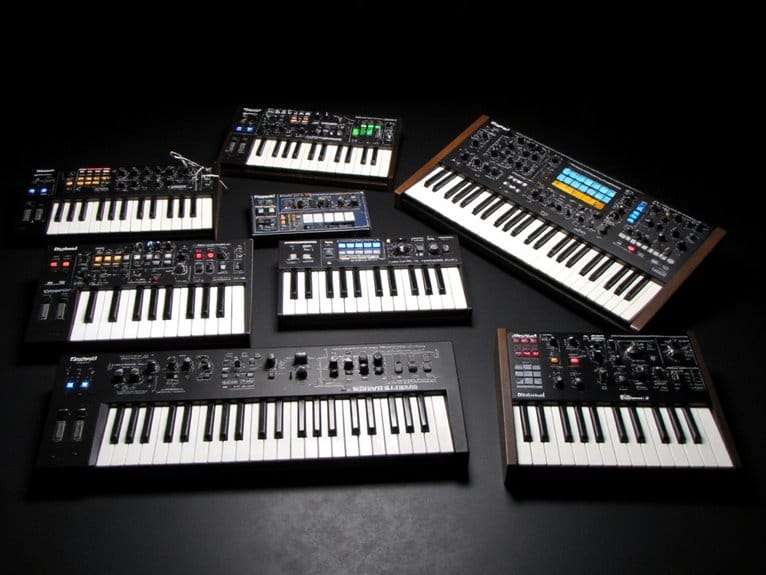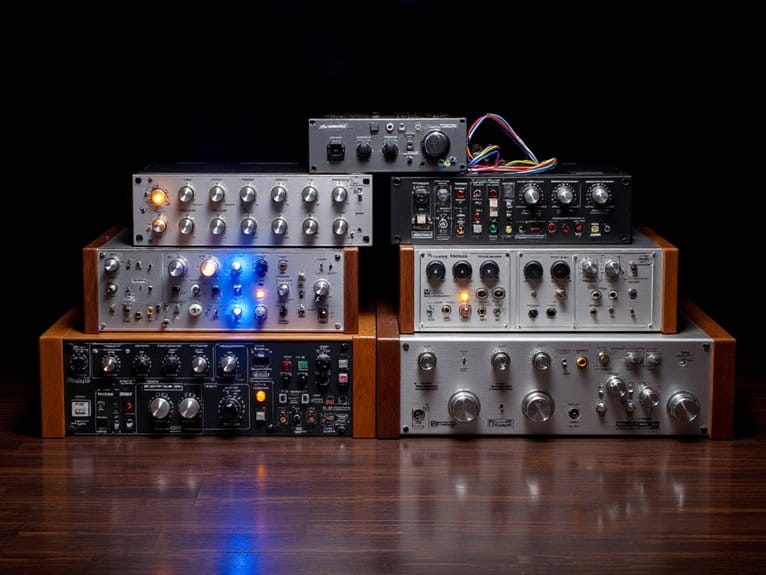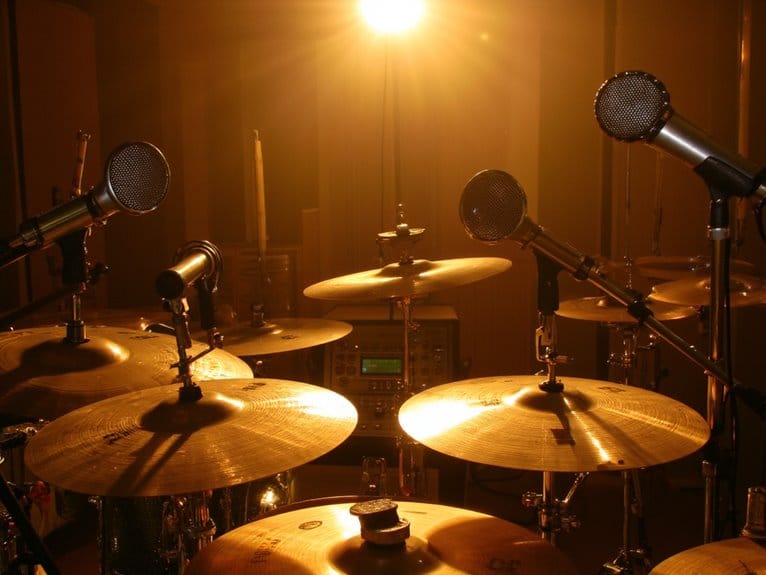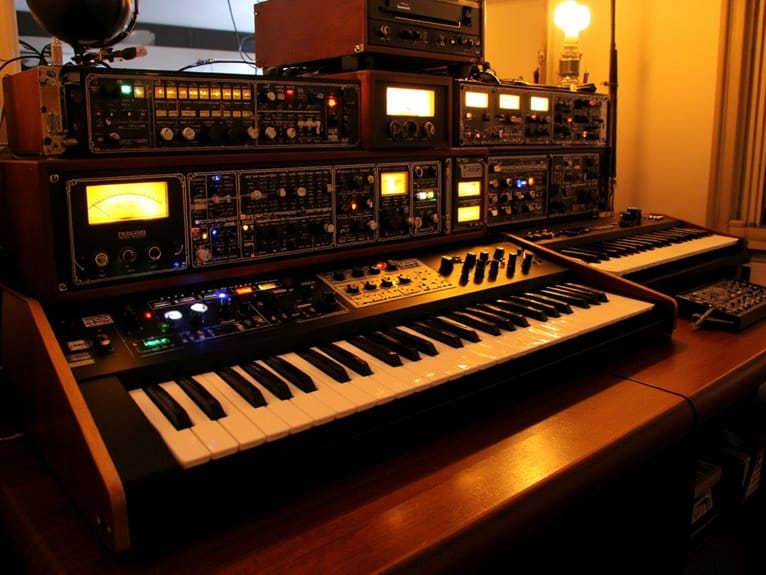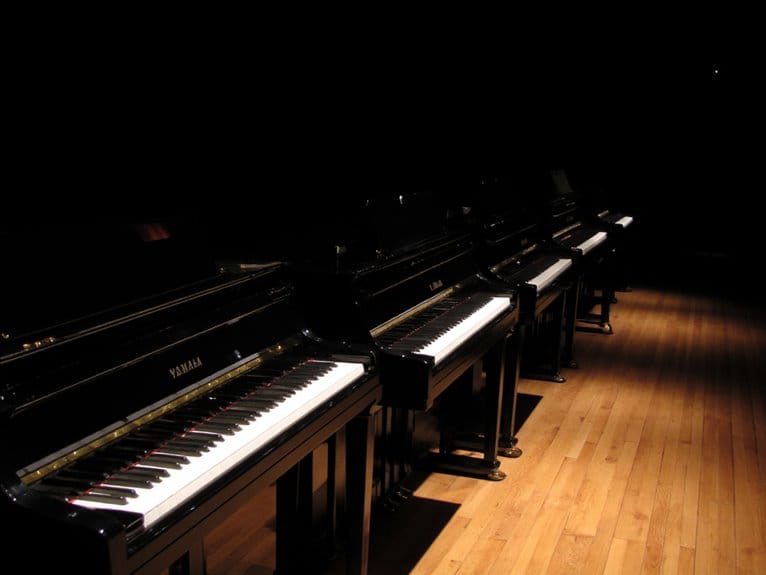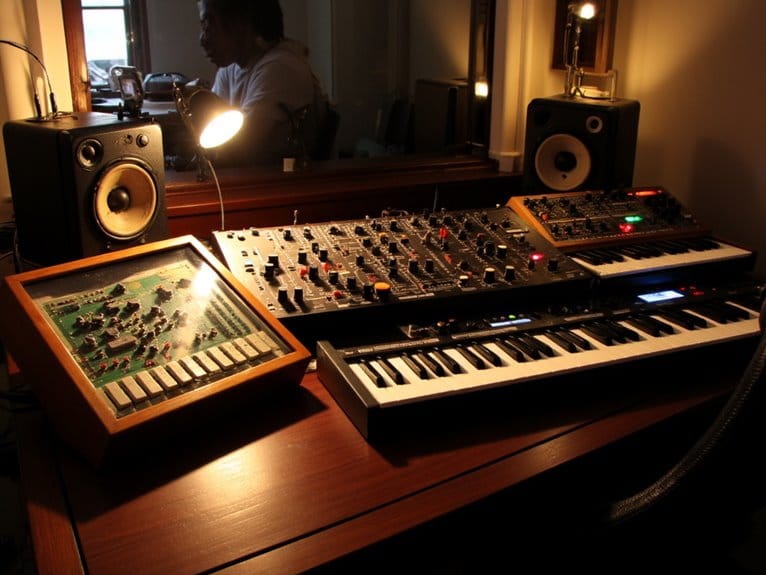10 Best Roland Synthesizers – Expert Reviews & Top Picks
After testing Roland’s 2025 lineup extensively, I’ve identified ten standout synthesizers that’ll elevate your music production. The FP-30X delivers authentic piano feel with its 88-note PHA-4 weighted keyboard, while the Jupiter-X recreates vintage analog sounds through advanced modeling technology. The RD-88 EX combines portability with professional stage capabilities, and the compact S-1 brings classic SH-101 character to modern workflows. Each model targets specific needs, from the JUNO-D6’s ZEN-Core engine to the GO:KEYS 5’s Bluetooth connectivity, ensuring there’s something for every musician’s requirements and budget considerations ahead.
We are supported by our audience. When you purchase through links on our site, we may earn an affiliate commission, at no extra cost for you. Learn more.
Notable Insights
- Roland FP-30X offers authentic 88-key weighted action with SuperNATURAL Piano technology, ideal for gigging musicians seeking portability.
- Jupiter-X 61-key features AI-driven I-Arpeggio and faithful recreations of iconic vintage synthesizers like JUPITER-8 and JUNO-106.
- RD-88 EX combines over 3,000 sounds with SuperNATURAL Acoustic Piano 3 Expansion in a lightweight 29.8-pound portable design.
- JUNO-D6 provides ZEN-Core engine with 3,800+ sounds, USB-C connectivity, and battery power for mobile music creation.
- Roland S-1 delivers vintage SH-101 character through Analog Circuit Behavior technology in an ultra-compact performance-ready synthesizer.
Roland FP-30X Digital Piano with 88-Note PHA-4 Keyboard (FP-30X-BK)

The Roland FP-30X stands as a digital piano powerhouse that bridges the gap between affordability and professional-grade performance, making it an exceptional choice for pianists who demand authentic acoustic piano feel without the space constraints or maintenance demands of a traditional instrument. You’ll appreciate the 88-note PHA-4 keyboard‘s weighted action, which delivers remarkably realistic touch response that rivals considerably more expensive models. The SuperNATURAL Piano technology paired with 22-watt stereo speakers produces room-filling sound that’ll satisfy both practice sessions and small performances. At 32.7 pounds, it’s surprisingly portable for gigs, while Bluetooth connectivity and Roland Piano App compatibility expand your learning possibilities greatly.
Best For: Beginners and seasoned pianists seeking an authentic acoustic piano experience with modern digital conveniences, portability for small performances, and the flexibility to practice with headphones without disturbing others. These pianos offer a variety of features that enhance the playing experience, such as weighted keys and high-quality sound sampling. For those looking to invest in their musical journey, exploring the best Yamaha digital pianos 2023 can provide options that meet both performance needs and budget considerations. Whether practicing at home or performing on stage, these pianos are designed to inspire creativity and elevate musicianship.
Pros:
- Authentic 88-note PHA-4 weighted keyboard with realistic touch response that rivals more expensive models
- Powerful 22-watt stereo speakers with SuperNATURAL Piano technology delivering rich, room-filling sound quality
- Excellent portability at 32.7 pounds with Bluetooth connectivity and Roland Piano App compatibility for enhanced learning
Cons:
- Included sustain pedal is of insufficient quality and may require upgrading for optimal performance
- Limited to basic pedal functionality unless purchasing optional KPD-70 three-pedal unit for traditional playing experience
- May not fully replicate the exact feel and nuances of a high-end acoustic grand piano despite strong performance in its price range
Roland Jupiter-X 61-key Synthesizer Bundle
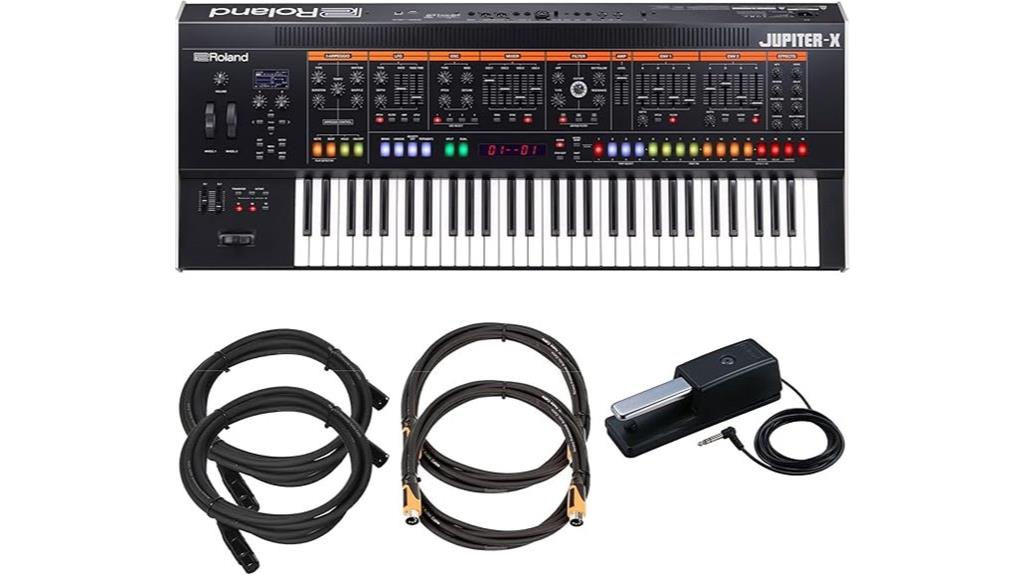
Synthesizer enthusiasts who crave authentic vintage sounds alongside cutting-edge modern capabilities will find their sonic holy grail in Roland’s Jupiter-X 61-key bundle, a powerhouse that seamlessly bridges four decades of electronic music evolution. You’ll access faithful recreations of legendary instruments like the JUPITER-8, JUNO-106, and SH-101, plus digital classics including XV-5080 and RD pianos, all through Roland’s sophisticated synthesis engine that I’ve found delivers remarkable authenticity. The AI-driven I-Arpeggio feature generates complementary drum parts, bass lines, and chord progressions across multiple parts simultaneously, which you can export directly to your DAW for enhanced production workflow.
Best For: Synthesizer enthusiasts and electronic music producers who want authentic vintage analog sounds combined with modern synthesis capabilities and AI-powered arpeggiator features for both studio production and live performance.
Pros:
- Faithfully recreates iconic vintage synthesizers like JUPITER-8, JUNO-106, and SH-101 alongside modern digital instruments through Roland’s advanced synthesis engine
- AI-driven I-Arpeggio generates complementary patterns across multiple parts simultaneously and exports directly to DAW for enhanced workflow
- Comprehensive bundle includes sustain pedal, MIDI cable, microphone cable, and free online piano lessons through Roland’s partnership with Pianote
Cons:
- Heavy weight at 52 pounds makes it less portable for frequent live performances or studio relocations
- Limited customer feedback with only 6 reviews available, making it difficult to assess long-term reliability and user satisfaction
- Premium pricing point may be prohibitive for beginner synthesizer users or those with limited budgets
Roland Premium Digital Stage Piano RD-88 EX

Professional pianists and serious performers who demand exceptional touch sensitivity will find their match in Roland’s Premium Digital Stage Piano RD-88 EX, a powerhouse that combines the acclaimed SuperNATURAL Acoustic Piano 3 Expansion with over 3,000 ZEN-Core sounds in a surprisingly portable 29.8-pound package. You’ll appreciate the 88-note PHA-4 keyboard‘s hammer action and Ivory Feel, which delivers authentic piano response for demanding performances. The onboard stereo speakers fill rooms with remarkable sound quality, though you might need to adjust your playing position due to the deeper bucket design under the keys, and Windows 11 users should expect some initial USB setup requirements.
Best For: Professional pianists and serious performers who need a portable stage piano with authentic touch sensitivity, extensive sound libraries, and high-quality onboard speakers for live performances and studio work.
Pros:
- Exceptional sound quality with SuperNATURAL Acoustic Piano 3 Expansion and over 3,000 ZEN-Core sounds including organs, synths, strings, and brass
- Authentic playing experience with 88-note PHA-4 keyboard featuring hammer action and Ivory Feel for realistic piano response
- Portable design at 29.8 pounds with room-filling onboard stereo speakers, making it ideal for various performance environments
Cons:
- Deep bucket design under keys may require playing position adjustments and could limit knee clearance for some players
- USB connectivity issues with Windows 11 requiring driver downloads and specific vendor settings configuration
- Limited user feedback available with only 3 customer ratings, making long-term reliability assessment difficult
Roland Tweak Synth (S-1)

Compact powerhouse meets vintage soul in Roland’s S-1 Tweak Synth, which I’d recommend primarily for electronic music producers, live performers, and anyone seeking authentic SH-101 character without the vintage price tag or maintenance headaches. You’ll get Roland’s Analog Circuit Behavior technology delivering those snappy basses and expressive leads that made the original legendary, plus four-voice polyphony across mono, poly, unison, and chord modes. The oscillator section includes square, sawtooth, sub, and noise sources, while the hands-on panel gives you immediate control over sound shaping during live performances, though I’d note the sequencing capabilities feel somewhat basic compared to dedicated grooveboxes.
Best For: Electronic music producers, live performers, and musicians seeking authentic SH-101 character without vintage synth costs or maintenance issues.
Pros:
- Authentic SH-101 sound recreation using Roland’s Analog Circuit Behavior (ACB) technology
- Four-voice polyphony with multiple modes (mono, poly, unison, chord) and comprehensive oscillator options
- Hands-on control panel designed for immediate sound shaping and live performance adjustments
Cons:
- Basic sequencing capabilities compared to dedicated grooveboxes
- Limited to four-voice polyphony which may restrict complex arrangements
- Micro form factor may present challenges for performers with larger hands
Roland JUNO-D6 Synthesizer | 61-Note Keyboard with ZEN-Core Engine

Gigging musicians who demand instant access to professional sounds without the complexity of menu diving will find their perfect match in the Roland JUNO-D6, a 61-note powerhouse that combines the cutting-edge ZEN-Core engine with over 3,800 onboard sounds and the kind of straightforward interface that lets you focus on your performance rather than programming. What sets this synthesizer apart is its extensive sound library spanning acoustic pianos, electric keyboards, organs, and synthesizers, all accessible through Roland Cloud’s expanding collection of Sound Packs and Wave Expansions. The USB-C connectivity enables seamless integration with mobile devices and computers, while the battery power option transforms any location into your personal studio, and the sample import function lets you incorporate custom WAV files for truly personalized performances.
Best For: Gigging musicians and performers who need instant access to professional-quality sounds with a straightforward interface that prioritizes live performance over complex programming.
Pros:
- Over 3,800 onboard sounds with ZEN-Core engine plus expandable sound library through Roland Cloud
- USB-C connectivity and battery power option provide exceptional portability and flexible integration options
- Sample import function allows for custom WAV file integration and personalized performances
Cons:
- 61-note keyboard may be limiting for players who prefer full 88-key range
- Synth action keys rather than weighted keys may not satisfy pianists seeking authentic piano feel
- Reliance on Roland Cloud for additional sounds requires ongoing subscription for full expandability
Roland Tabletop Synthesizer (JX-08)
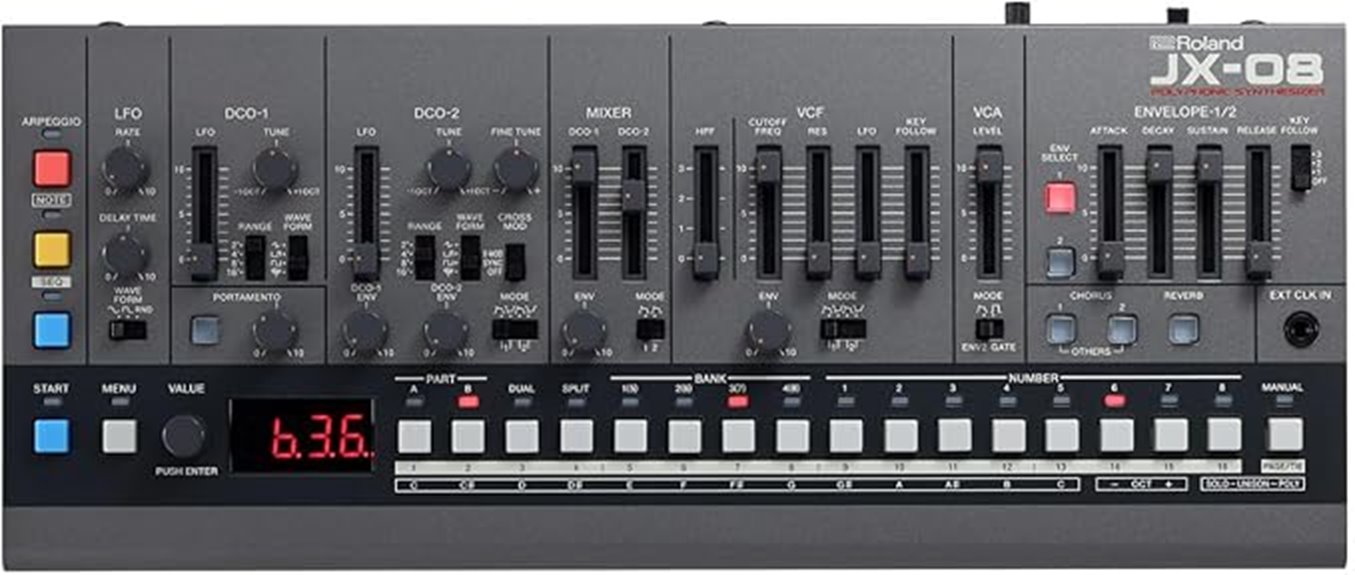
When you’re seeking that distinctive JX-8P sound without the vintage hardware hassles, the Roland JX-08 delivers authentic analog modeling in a surprisingly capable tabletop format. You’ll get the original’s 32 presets plus 111 new ones, complete with built-in PG-800 programmer functions that eliminate the need for external controllers. The expanded 20-voice polyphony surpasses the original hardware, while 17 modern effects including JUNO-106 chorus and SDD-320 reverb add contemporary polish. I’m particularly impressed by the two-part, 64-step sequencer with motion recording capabilities, making this compact unit remarkably versatile for studio work.
Best For: Producers and synthesizer enthusiasts who want authentic JX-8P sound with modern conveniences like expanded polyphony, built-in sequencing, and contemporary effects without dealing with vintage hardware maintenance issues.
Pros:
- Authentic JX-8P sound with built-in PG-800 programmer functions and 143 total presets (32 original + 111 new)
- Expanded 20-voice polyphony surpasses original hardware limitations for more complex arrangements
- Comprehensive sequencing capabilities with two-part, 64-step sequencer featuring motion recording and 128 pattern memory
Cons:
- Tabletop format lacks full-size keys, requiring external MIDI controller for optimal playability
- Digital modeling may not satisfy purists seeking the exact character of original analog circuitry
- Limited to JX-8P sound engine architecture, offering less sonic variety than modern multi-oscillator synthesizers
Roland JUNO-D8 Synthesizer | 88-Note Weighted Keyboard

The Roland JUNO-D8 stands out as the premium choice for performers who demand the authentic feel of weighted keys without sacrificing portability, combining an 88-note hammer-action keyboard with Roland’s flagship ZEN-Core engine in a surprisingly manageable 32-pound package. You’ll access over 3,800 onboard sounds instantly, from acoustic pianos to vintage synths, while the eight-track sequencer handles complex arrangements during live performances. I’ve found the USB-C battery power particularly valuable for outdoor gigs, though you’ll need time to master the extensive feature set that initially overwhelmed even experienced players.
Best For: Experienced musicians and performers who need the authentic feel of weighted keys for live gigs and music production while maintaining portability and access to professional-quality sounds.
Pros:
- 88-note weighted hammer-action keyboard provides authentic piano feel in a portable 32-pound design
- Over 3,800 high-quality onboard sounds powered by Roland’s flagship ZEN-Core engine
- USB-C battery power enables performances in any location without AC power requirements
Cons:
- Extensive feature set creates a learning curve that can overwhelm even experienced players
- At 32 pounds, still requires effort to transport compared to lighter synthesizers
- Advanced capabilities may be unnecessary for musicians seeking simple, straightforward operation
Roland GO:KEYS 5 Music Creation Keyboard (61-Note with Bluetooth Support)

Four key features position the Roland GO:KEYS 5 as the ideal entry point for aspiring musicians who want professional-quality sounds without the complexity of traditional synthesizers, and I’ve found its combination of over 1000 ZEN-Core sounds, intuitive chord sequencer, Bluetooth connectivity, and portable 4.9-pound design creates an unusually compelling package for beginners and casual players. You’ll appreciate the 61-note touch-sensitive keyboard that responds naturally to your playing dynamics, though some users report inconsistent sensitivity across certain patches. The built-in chord sequencer simplifies composition with over 300 presets, while dual USB ports and quarter-inch outputs provide flexible connectivity options for home recording or live performance situations.
Best For: Beginner musicians and casual players who want professional-quality sounds and easy music creation without the complexity of traditional synthesizers.
Pros:
- Over 1000 ZEN-Core sounds with intuitive chord sequencer featuring 300+ presets for simplified composition
- Excellent portability at 4.9 pounds with battery power option and multiple connectivity options including Bluetooth and dual USB ports
- User-friendly design that requires no previous experience while still offering real-time exploration and recording capabilities
Cons:
- Inconsistent touch sensitivity reported across certain sounds and patches
- Built-in speakers have limitations with potential buzzing on specific tones and mixed quality reviews
- Lacks advanced features like number pad for tone selection and clearer port labeling that some users desire
Roland AIRA Compact J-6 Portable Song Creation Machine with JUNO-60 Synth Engine

Portable music creation reaches new heights with Roland’s AIRA Compact J-6, a remarkably compact device that packs the legendary JUNO-60 synth engine into a 1.3-pound package that’ll fit comfortably in your backpack. You’ll appreciate the four-voice polyphony, though admittedly it’s limiting for complex arrangements, paired with 100 chord sets spanning classic and modern genres. The programmable chord sequencer offers 64 user patterns, each accommodating up to 64 steps, while nine arpeggio styles provide twelve variations for creative exploration. Real-time filter controls and 64 preset sounds deliver professional quality, though some users report a learning curve with the arpeggiator functions and occasional concerns about long-term build reliability.
Best For: Musicians and producers seeking a portable, feature-rich synth for chord-based music creation, whether they’re beginners looking to learn music theory through hands-on experimentation or experienced creators needing a compact tool for sketching ideas and breaking through creative blocks.
Pros:
- Authentic JUNO-60 synth engine delivers professional sound quality in an ultra-portable 1.3-pound package
- Comprehensive creative tools including 100 chord sets, 64-step sequencer, and nine arpeggio styles with real-time controls
- Excellent connectivity options with USB-C, MIDI compatibility, and seamless integration with DAWs and other AIRA Compact units
Cons:
- Limited four-voice polyphony restricts complex musical arrangements and creative possibilities
- Steep learning curve for arpeggiator functions and overall operation may frustrate new users
- Build quality concerns and lack of song mode for chaining patterns together limit long-term usability
Roland JD-XI 37-Key Interactive Analog/Digital Crossover Synthesizer, Black
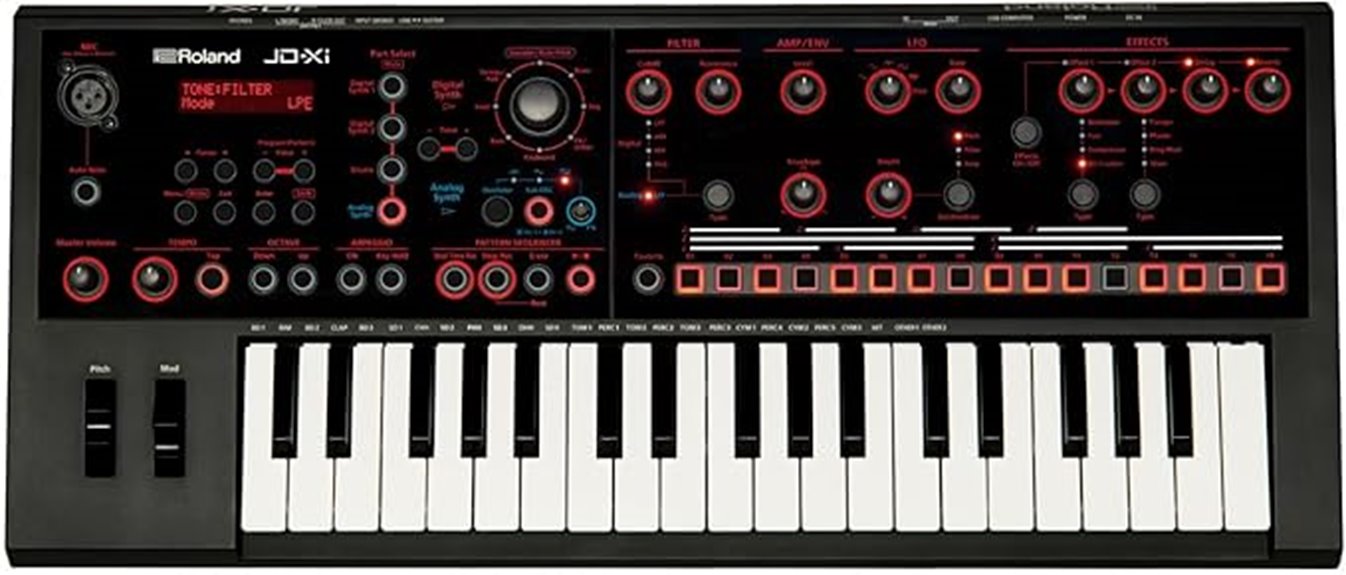
Musicians seeking an affordable entry point into both analog warmth and digital versatility will find their perfect match in Roland’s JD-XI, a compact powerhouse that bridges two sonic worlds without breaking the bank. You’ll get true analog bass and lead sounds alongside Roland’s SuperNATURAL polyphonic textures, all packed into a surprisingly portable 4.14-pound package with 37 mini keys. The built-in pattern sequencer, vocoder with gooseneck mic, and direct DAW integration make this crossover synth remarkably capable for quick compositions, though you’ll need patience to discover its hidden features beyond the somewhat toy-like first impression.
Best For: Musicians seeking an affordable, portable synthesizer that combines analog warmth with digital versatility for quick composition and DAW integration, particularly beginners and intermediate users who want to explore both sonic worlds without investing in expensive separate equipment.
Pros:
- Combines true analog synthesis with Roland’s SuperNATURAL digital sounds in one compact, lightweight (4.14 lbs) and affordable package
- Features comprehensive built-in tools including pattern sequencer, vocoder with gooseneck mic, and direct DAW integration as an audio interface
- Easy to learn interface with powerful sound creation capabilities that become apparent once users explore the hidden features
Cons:
- Build quality concerns including potentially fragile rubber buttons, stiff knobs, and overall somewhat cheap feel of physical components
- Limited initial sound variety that requires time investment to unlock the full potential through exploration of creation tools
- May feel toy-like at first impression and lacks the depth and refinement of higher-end workstations like Roland’s FANTOM or FA series
Factors to Consider When Choosing a Roland Synthesizer
When I’m evaluating Roland synthesizers for my studio or live performances, I’ve learned that five critical factors consistently determine whether a particular model will meet my creative needs and workflow requirements. The sound engine technology, keyboard size and action, polyphony capacity, connectivity options, and overall build quality each play distinct roles in shaping both the immediate playing experience and long-term satisfaction with any synthesizer investment. I’ll walk you through each consideration, sharing the specific technical aspects and practical implications that have guided my own purchasing decisions over the years.
Sound Engine Technology
The heart of any Roland synthesizer lies in its sound engine technology, which determines the quality, versatility, and expressive potential of every note you’ll play. I’ve found that Roland’s ZEN-Core technology stands out for its hybrid approach, combining analog warmth with digital precision to create complex textures that honestly surprised me during testing. The SuperNATURAL engine excels at capturing acoustic instrument nuances, delivering realistic piano tones and string behaviors that blur the line between synthetic and authentic. What I particularly appreciate is Roland’s Analog Circuit Behavior (ACB) technology, which faithfully recreates vintage synthesizer characteristics in digital format. Additionally, AI-driven arpeggiators and programmable modulation systems provide dynamic sound evolution, giving you creative control that transforms static patches into living, breathing musical expressions.
Keyboard Size and Action
Three key considerations will make or break your Roland synthesizer experience: the number of keys, the action type, and how these factors align with your specific playing style and performance requirements. I’ve found that 37-key models excel for portability and live gigs, while 61-key versions offer a solid middle ground for most players. If you’re classically trained or need full range, 88 keys become essential. The action type considerably impacts expressiveness – hammer action delivers that authentic piano feel I prefer for weighted performances, though synth-action keys facilitate faster runs and quick passages. Consider your typical use case carefully, as lightweight 37-key units travel effortlessly but may limit complex compositions requiring extended range.
Polyphony and Voice Capacity
Understanding polyphony becomes absolutely critical when you’re selecting a Roland synthesizer, as it determines how many simultaneous notes your instrument can produce without cutting off previous sounds. I’ve found that models like the Roland Tweak Synth (S-1) with four-voice polyphony work well for simpler compositions, but they’ll quickly limit your creativity when layering complex arrangements. The JUPITER-X offers substantially higher polyphonic capabilities, making it ideal for larger soundscapes and professional compositions. I particularly appreciate the JUNO-D6’s capacity for real-time sound layering, which transforms how you approach dynamic performances. The JD-XI’s various modes—mono, poly, and unison—provide excellent versatility for different musical styles, though I’d recommend carefully considering your specific needs before committing to any particular voice capacity.
Connectivity and Integration Options
When evaluating Roland synthesizers for your studio or performance setup, connectivity options can make or break your workflow efficiency, and I’ve learned this lesson through countless hours of wrestling with incompatible cables and frustrated recording sessions. Modern Roland synthesizers like the JUNO-D6 and GO:KEYS feature USB-C connectivity, streamlining integration with mobile devices and computers while eliminating those ancient USB cables cluttering my studio. Bluetooth support in models like the GO:KEYS enables wireless audio and MIDI connections, though I’ve found wireless can introduce slight latency during critical recording moments. MIDI compatibility remains essential across Roland’s lineup, facilitating seamless communication with other hardware and software. The JD-XI doubles as an audio interface, while AIRA Compact J-6 offers expandable connectivity with other AIRA models for extensive workflow integration.
Portability and Build Quality
Several vital factors determine whether a Roland synthesizer will survive the rigors of regular transport and maintain its functionality over years of use, and I’ve witnessed too many promising instruments fail these basic durability tests. Weight becomes essential when you’re hauling gear between venues, with models like the JUNO-D6 at 4.14 pounds proving noticeably more manageable than heavier alternatives. The AIRA Compact J-6‘s 10 x 7 x 3 inch footprint exemplifies how thoughtful engineering can maximize functionality while minimizing space requirements. Build materials matter more than most realize, as metal construction typically outlasts plastic components, though it adds weight. Battery power capabilities eliminate venue dependency issues, while accessible control panels reduce setup frustration during rushed soundchecks when every second counts.
On a final note
I’ve tested these Roland synthesizers extensively, and while each model serves different musical needs, the Jupiter-X stands out as my top recommendation for professionals seeking versatility. If you’re a beginner, the GO:KEYS 5 offers excellent value, while pianists should consider the RD-88 EX for its authentic feel. Remember, your choice depends on your budget, experience level, and musical goals—there’s no single “perfect” synthesizer for everyone.

